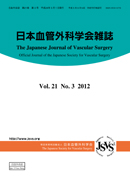Volume 21, Issue 7
Displaying 1-18 of 18 articles from this issue
- |<
- <
- 1
- >
- >|
Original Article
-
2012 Volume 21 Issue 7 Pages 763-768
Published: December 25, 2012
Released on J-STAGE: December 28, 2012
Download PDF (563K)
Case Reports
-
2012 Volume 21 Issue 7 Pages 769-772
Published: December 25, 2012
Released on J-STAGE: December 28, 2012
Download PDF (731K) -
2012 Volume 21 Issue 7 Pages 773-780
Published: December 25, 2012
Released on J-STAGE: December 28, 2012
Download PDF (1371K) -
2012 Volume 21 Issue 7 Pages 781-783
Published: December 25, 2012
Released on J-STAGE: December 28, 2012
Download PDF (462K) -
2012 Volume 21 Issue 7 Pages 785-789
Published: December 25, 2012
Released on J-STAGE: December 28, 2012
Download PDF (1129K) -
2012 Volume 21 Issue 7 Pages 791-794
Published: December 25, 2012
Released on J-STAGE: December 28, 2012
Download PDF (666K) -
2012 Volume 21 Issue 7 Pages 795-798
Published: December 25, 2012
Released on J-STAGE: December 28, 2012
Download PDF (1102K) -
2012 Volume 21 Issue 7 Pages 799-802
Published: December 25, 2012
Released on J-STAGE: December 28, 2012
Download PDF (686K) -
2012 Volume 21 Issue 7 Pages 803-808
Published: December 25, 2012
Released on J-STAGE: December 28, 2012
Download PDF (1018K) -
2012 Volume 21 Issue 7 Pages 809-812
Published: December 25, 2012
Released on J-STAGE: December 28, 2012
Download PDF (784K) -
2012 Volume 21 Issue 7 Pages 813-816
Published: December 25, 2012
Released on J-STAGE: December 28, 2012
Download PDF (551K) -
2012 Volume 21 Issue 7 Pages 817-819
Published: December 25, 2012
Released on J-STAGE: December 28, 2012
Download PDF (603K) -
2012 Volume 21 Issue 7 Pages 821-824
Published: December 25, 2012
Released on J-STAGE: December 28, 2012
Download PDF (964K) -
2012 Volume 21 Issue 7 Pages 825-827
Published: December 25, 2012
Released on J-STAGE: December 28, 2012
Download PDF (447K) -
2012 Volume 21 Issue 7 Pages 829-832
Published: December 25, 2012
Released on J-STAGE: December 28, 2012
Download PDF (908K) -
2012 Volume 21 Issue 7 Pages 833-837
Published: December 25, 2012
Released on J-STAGE: December 28, 2012
Download PDF (2345K) -
2012 Volume 21 Issue 7 Pages 839-842
Published: December 25, 2012
Released on J-STAGE: December 28, 2012
Download PDF (868K) -
2012 Volume 21 Issue 7 Pages 843-847
Published: December 25, 2012
Released on J-STAGE: December 28, 2012
Download PDF (989K)
- |<
- <
- 1
- >
- >|
